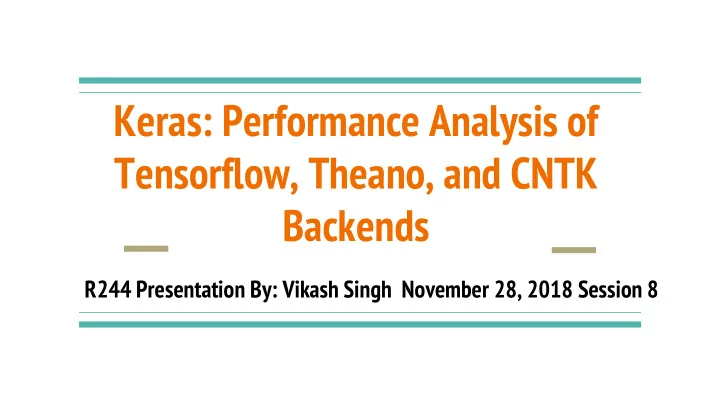

Keras: Performance Analysis of Tensorflow, Theano, and CNTK Backends R244 Presentation By: Vikash Singh November 28, 2018 Session 8
What is Keras [1] ? ● High level neural networks API in Python that is capable of running on top of TensorFlow [2] , CNTK [3] , or Theano [4] ● Focus on enabling fast experimentation ● Supports feedforward, convolutional, and recurrent neural networks ● Runs on both CPU and GPU
Code Example: Understanding Keras Abstractions
Analyzing Performance with Different Backends ● “Backend engine” of Keras takes high level building blocks and converts to low level code ● Goal: Experimentally analyze the performance of different backends in different computing environments (local vs cluster) ● Practical usage for understanding if there is a significant difference, can be exploited in production use case
Experimental Methods ● Train deep neural network locally (CPU) on MNIST digit recognition dataset using Keras and use Theano, TensorFlow, and CNTK backends ● Use Google Cloud ML to run the exact same job on three GPU environments: A single NVIDIA Tesla K80 GPU ○ Four NVIDIA Tesla K80 GPUs ○ Eight NVIDIA Tesla K80 GPUs ○
Key Questions ● Are there any significant performance differences across the board? ● Do certain backends perform better in certain computing environments? ● Do we see identical model performance across the different backends? ● Can we link the design of these systems to the observed results?
Future Work ● Analyzing these trends not only across various computing environments but also different neural network models (CNNs, RNNs, etc) ● Testing on more heterogeneous computing environments (mixtures of CPUs, GPUs, etc) ● Comparing Keras implementation to native implementation of exact same architectures
Progress ● Planned out experiments, selected platforms for running GPU cluster on cloud ● Began training neural networks on Keras locally using MNIST dataset ● To Do: Perform actual experiments (locally and using Google Cloud) and record/analyze results, see what parts of future work can be done
References 1. Chollet, François. "Keras." (2015). 2. Abadi, Martín, Paul Barham, Jianmin Chen, Zhifeng Chen, Andy Davis, Jeffrey Dean, Matthieu Devin et al. "Tensorflow: a system for large-scale machine learning." In OSDI , vol. 16, pp. 265-283. 2016. 3. Seide, Frank, and Amit Agarwal. "CNTK: Microsoft's open-source deep-learning toolkit." In Proceedings of the 22nd ACM SIGKDD International Conference on Knowledge Discovery and Data Mining , pp. 2135-2135. ACM, 2016. 4. Bergstra, James, Frédéric Bastien, Olivier Breuleux, Pascal Lamblin, Razvan Pascanu, Olivier Delalleau, Guillaume Desjardins et al. "Theano: Deep learning on gpus with python." In NIPS 2011, BigLearning Workshop, Granada, Spain , vol. 3, pp. 1-48. Microtome Publishing., 2011.
Recommend
More recommend